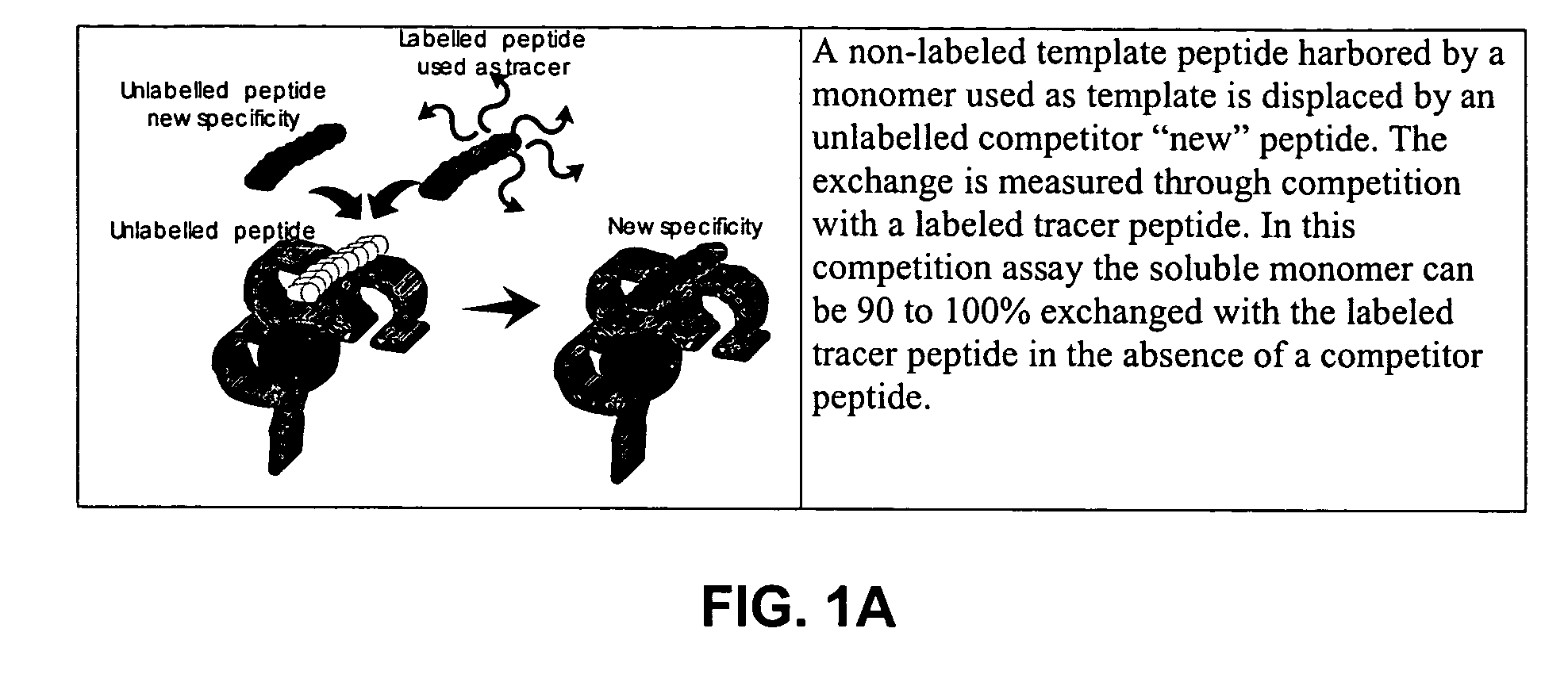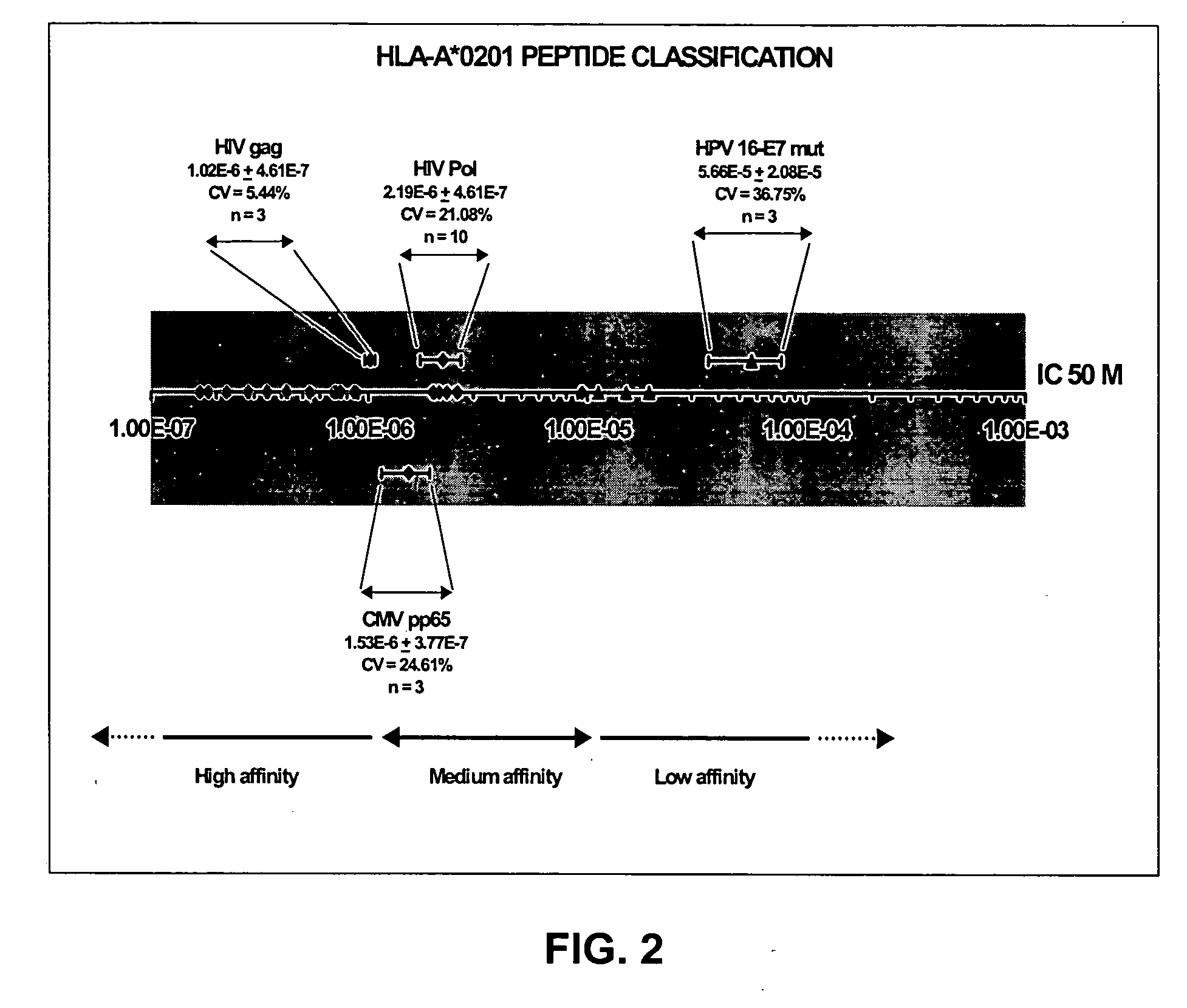Solution-based methods for detecting MHC-binding peptides
a technology of mhc-binding peptides and solution-based methods, which is applied in the field of immunoassays to detect and measure binding, can solve the problems of not being globally effective, most prediction methods are limited to a set of alleles, and assays that do not yield an absolute dissociation constant, etc., and achieve rapid comparison and quantifying. , the effect of rapid comparison and quantification
- Summary
- Abstract
- Description
- Claims
- Application Information
AI Technical Summary
Benefits of technology
Problems solved by technology
Method used
Image
Examples
example 1
[0105] This example illustrates selection of the monomer / peptide combination to be used as template monomer for the peptide exchange assays. Experiments were carried out with HLA A*0201 and a series of known peptides. Previous experiments in the laboratory indicated the peptide Mart-1 27-35 (Kawakami, et al., 1994a Proc. Natl. Acad. Sci. USA. 91: 3515-3519) as well as peptide Mart-1 26-35 (Kawakami, et al., 1994b J. Exp. Med. 180: 347-352), derived from melanoma cells, could be excellent candidates to manufacture monomer template. Both peptides, which have amino acid sequences AAGIGILTV and EAAGIGILTV respectively, have been described as a low and medium affinity peptides for the HLA-A*0201 molecule (Valmori, et al. 1998 (1998) J. Immunol. 161:6956-6962; Kuhns, et al., 1999 J. Biol. Chem. 274(51):36422-36427; Men, et al., 1999 J. Immunol. 162:3566-3573).
[0106] The HIVpol peptide (Tsomides, et al., 1991 Proc. NatL. Acad. Sci. USA. 88:11276-11280), which naturally has a lysine in pos...
example 2
[0133] To understand better what happened during the exchange, the anti-beta-2 microglobulin monoclonal antibody B1G6, which recognizes an epitope located outside the interface of interaction between the heavy chain and beta-2 microglobulin, was coupled to PE and used to quantify the exchanged monomer accurately as well as to have an idea of the amount of monomer dissociation that took place.
Measurement of Monomer Dissociation Level and Quantification of Total Monomer.
[0134] In this immunometric assay, as illustrated in FIG. 7, the monomer is bound first to the avidin coated plates via a biotin tag engineered at the C-terminal end of the heavy chain. After the plates were washed, the B1G6 mAb was added so as to allow binding of the beta-2 microglobulin associated with the heavy chain in the monomer. The immunometric assay was performed in two steps. The first step involves incubation of the monomer for coating. Then, after washing to remove unbound components, and particularly fr...
example 3
Peptide Exchange and Cellular Staining.
[0144] One of the uses of the invention peptide exchange methods is in the generation of tetramers with a new specificity without doing the entire monomer folding process. To confirm utility of MHC tetramer assays utilizing exchanged monomers for staining T cells, the staining pattern obtained with monomers containing directly folded peptides rather than exchanged peptides was compared. To make that comparison three different peptides for which specific cell lines are available were selected.
Description of Cells Used in this Study.
Mart 1 Specific Cell Line.
[0145] Jurkat P1 / 1 CD8 clone 5.2 Jurkat P1 / 1 CD8 clone 5.2 is CD3+, CD4+, CD8+, Vb6.7+. The TCR recognizes the Melan A “wild type” peptide (AAGIGILTV) (Mart-1 27-35), but the decamer (EAAGIGILTV) (Mart-1 26-35) and the mutated peptide (26-35L, also called 27L in the literature (ELAGIGILTV) are better recognized. The same type of cell was prepared without CD8. The CD8− cell (called Jurk...
PUM
| Property | Measurement | Unit |
|---|---|---|
| half life | aaaaa | aaaaa |
| temperature | aaaaa | aaaaa |
| temperature | aaaaa | aaaaa |
Abstract
Description
Claims
Application Information
 Login to View More
Login to View More - R&D
- Intellectual Property
- Life Sciences
- Materials
- Tech Scout
- Unparalleled Data Quality
- Higher Quality Content
- 60% Fewer Hallucinations
Browse by: Latest US Patents, China's latest patents, Technical Efficacy Thesaurus, Application Domain, Technology Topic, Popular Technical Reports.
© 2025 PatSnap. All rights reserved.Legal|Privacy policy|Modern Slavery Act Transparency Statement|Sitemap|About US| Contact US: help@patsnap.com



